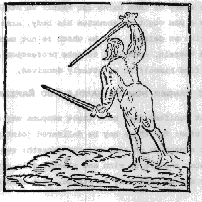Hi dan I hope all goes well great to see you again
Quote:
|
Originally Posted by fearn
Hi All,
One other thing about double blades is, to state the obvious, they are both blades, and they are both same length.
Why does this matter? Shields tend to be cheaper than swords, and they cover more than a sword does. As such, they're better for defense than a second sword. If necessary, they can be torn to bits defending their wielder. That's why lots of people use shields, especially when they can only afford one good sword.
Thing about paired long weapons of the same length is that they tend to get in each other's way. There are three solutions for this. One is to get really, really good, like Musashi. A second is to use shorter blades, which is what many paired weapons practices (in China, Europe, Japan, and SE Asia) do. Of course, this means you've surrendered the range advantage to your opponent. A third solution is to use a long/short blade combo, which was done in the Philippines, Europe, and China. Oh yeah, I think Musashi did it as well.
Anyway, double weapons have some notable weaknesses, which is why double blades aren't common. The warriors who use them tend to be somewhat better than average.
The weird thing actually is that the Dao isn't used with a shield very often. Wonder why?
Best,
F
|
Actually Phillipine arts use weapons of different length but also 2 weapons of the same length such as double espada and double baston. Yes it is more common to see espada y daga There are a number of other styles that also use double blades. Burmese Thaing, Krabi Krabong ( daab song muu ) both already mentioned , Chinese had dual jian and dual dao some long some shorter , Pencak Silat has double blade forms, in WMA there was a case ( or brace) of rapier using dual rapiers as well as sword and dagger forms ( Manciolino (1531), Marozzo (1536), Agrippa (1553), di Grassi (1570) ) , as mentiond above there seems to have been some use of double falchions, some sources speak of indonesian forms with dual peudeung on Aceh. Kuk Sool won has dual blade techniques ( Sang Kum or on horse Ma Sang Sang Kum), Musashi's treatise on it has been mentioned above. I am sure there are others that do not come to mind but there are many historical examples of dual swords.


Though the argument about double blades/sword and shield/sword and axe will go on long beyaond our lifespan and I will admit dual sword forms were probably not the norm nor used by conscripts who were farmers oneday and fighters the next. The pike and spear were probably the weeapon of conscripts. And I belief the dha was often used with a shield but the sields were of rattan and wood so mot as many survived as we collectors would wish
As to the original question of how common daab song muu was I do not know that we will ever know. With chinese double blades the blades themselfs and thier furniture were crafted to fit two blades in one scabbard. With daab song muu they are in separate scabbards. Because of this the swords could be used as paired blades by one generation and then passed down to the next where they might be used as single blades possibly by two different people. I like to think that when I see two identical dha with definite age to them ( which does happen some) that they may have been used daab song muu but I could just as easily be letting romaticism tint my judgement
As to there being difficulty using two weapons and the need for more training I agree completely with that and leave the words of DiGrassi about a case of rapiers
There are also used now adays, aswell in the schools, as in
the lists, two Swords or Rapiers, admitted, and approved
both of Princes, and of the professors of this art, for
honorable and knightly weapons, albeit they be not used in
the wars. Wherefore I shall not vary from my purpose, if I
reason also of these, as far as is agreeable to true art. To
him that would handle these weapons, it is necessary that he
can aswell manage the left hand as the right, which thing
shalbe (if not necessary) yet most profitable in every other
kind of weapon. But in these principally he is to resolve
himself, that he can do no good, without that kind of
nimbleness and dexterity. For seeing they are two weapons,
and yet of one self same kind, they ought equally and
indifferently to be handled, the one performing that which
the other does, and every of them being apt aswell to strike
as defend. And therefore a man ought to accustom his body,
arms and hands aswell to strike as defend. And he which is
not much practiced and exercised therein, ought not to
make profession of this Art: for he shall find himself to be
utterly deceived.